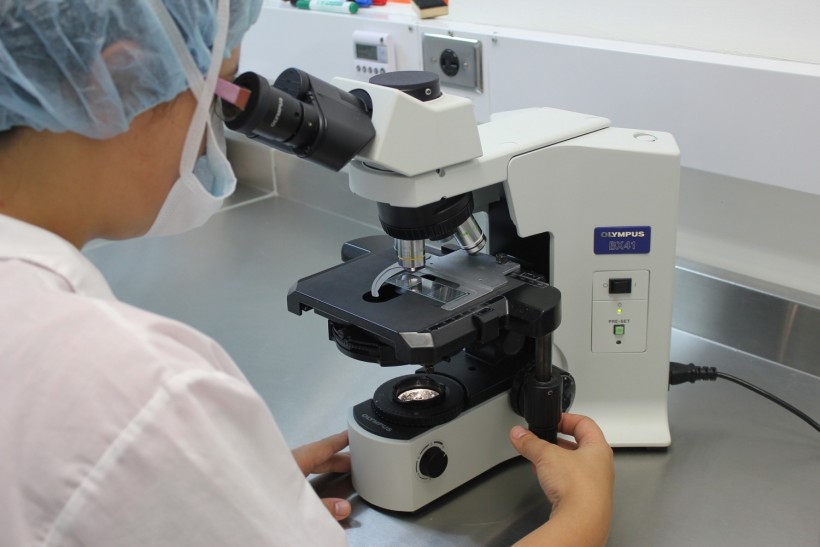Florida residents are contending with a deadly threat due to the spike in flesh-eating bacteria driven by the surging floods.

Microscope Laboratory Diagnosis
Vibrio Vulnificus
According to data from Florida's Department of Health, cases of Vibrio vulnificus, which lives in brackish, salty waters, have doubled since the hurricane devastated West and Central Florida. The state has reported 64 infections and 13 deaths this year. In 2021, there were only 34 cases and 10 deaths recorded.
The reason behind such an infection is that bacteria thrive in brackish floods, where sewage spills into coastal water.
Experts told Newsweek that even before Hurricane Ian, Vibrio vulnificus, was already increasing.
Flesh-Eating Bacteria Growth in Gulf Coastal Water
According to Dr. Peter Hotez, dean of the National School of Tropical Medicine at Baylor College of Medicine, Vibrio vulnificus is growing in Gulf coastal waters as a result of sewage dumping, salinity reductions, and warming temperatures brought on by climate change.
He said that the factors can also become confluent during tropical storms and hurricanes.
People who come into contact with contaminated water and have open wounds, scrapes, or abrasions risk contracting the bacteria.
Bacteria on Wounds Lead to Organ Failure
Dr. Anthony Ouellette, a professor of biology and chemistry at Jacksonville University, said that some of those bacteria will stick to the wounds. They'll get into it and they'll take a hold of it. Then they'll divide and divide and divide to really high numbers. When they do this, they start releasing toxins, some of which will break down the person's tissue.
The bacteria can enter the body after destroying the tissue around a wound, which can result in septicemia and organ failure. While some patients may need operations or amputations, others may pass away within a few days.
Eating Raw Food
Eating raw seafood, especially oysters, can cause infections. In estuaries and salt marshes where oysters dwell, the bacteria adhere to particles.
According to Ouellette, an oyster consumes such particles through a filter feeding process. Oysters powerfully pump water.
A viral tweet from user @Priscilla_dgaf said to avoid raw sushi and raw seafood for the next few weeks. She warned that there have been some flesh-eating bacteria cases going on.
Whatever y’all do , DO NOT EAT RAW SUSHI or any RAW seafood for the next few weeks. After hurricane Ian, there has been some flesh-eating bacteria cases going on!
— P.JIMENEZ (@Priscilla_dgaf) October 19, 2022
Although the tweet received over 60,000 likes and 25,000 retweets, Ouellette claimed that it is unlikely that sushi would cause you to get Vibrio vulnificus.
He claimed that everything at the water's surface could be polluted. Usually, individuals who eat raw fish do not consume the skin. You are unlikely to become ill if you are not eating the skin or if the skin has been cooked. However, if you handle raw seafood before boiling it and you have a cut on your hand, you could become contaminated.
Hotez and Ouellette both stressed that each person's level of risk is very different. Although the disease has claimed the lives of some young, healthy people, those who are immunocompromised, have diabetes, liver disease, or kidney disease face a significantly higher risk of developing a serious sickness.
If you notice symptoms of a skin infection, such as swelling, redness, or blisters, they urged getting medical help. Additionally, you can get a fever, chills, nausea, vomiting, and diarrhea. Calling the doctor is also advised if a cut seems unusually hot to the touch or hurts more than it should.
RELATED ARTICLE: Hazardous Flesh-Eating Ulcer in Australia May Be From Endangered Possums
Check out more news and information on Medicine and Health in Science Times.










!['Cosmic Glitch' in Einstein's Theory of General Relativity Could Be Explained in This New Scientific Tweak [Study]](https://1721181113.rsc.cdn77.org/data/thumbs/full/53435/258/146/50/40/cosmic-glitch-in-einsteins-theory-of-general-relativity-could-be-explained-in-this-new-scientific-tweak-study.jpeg)



